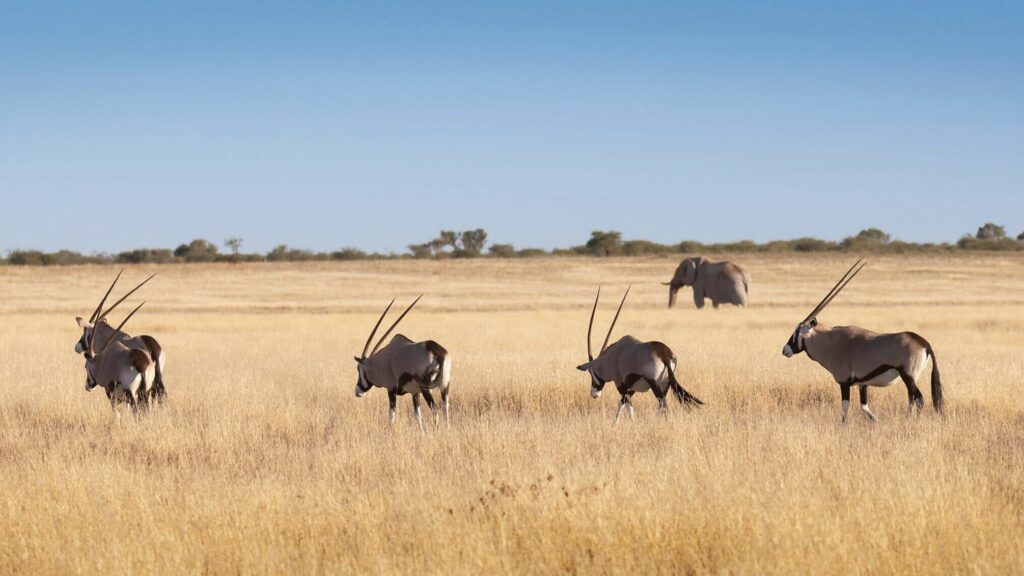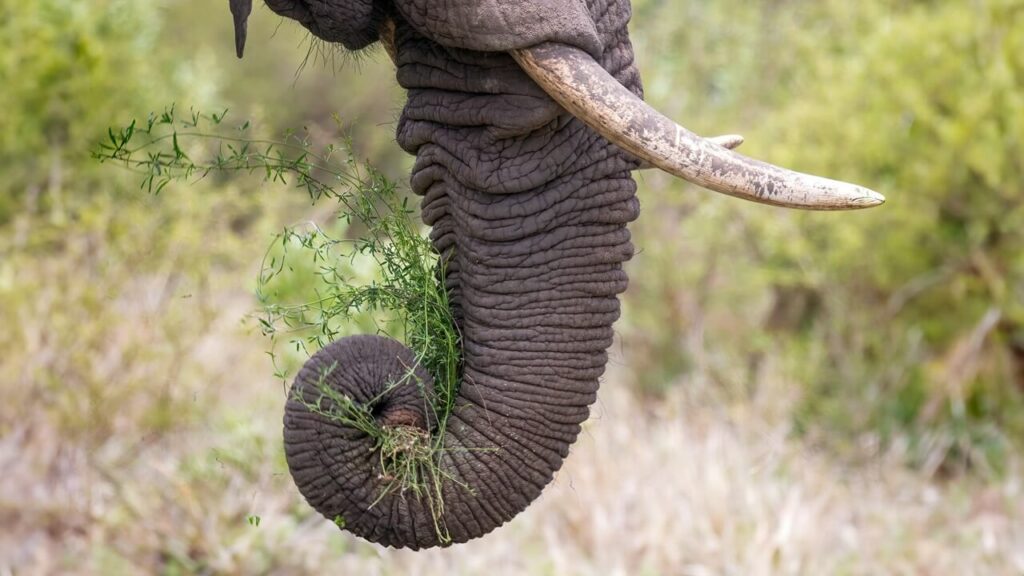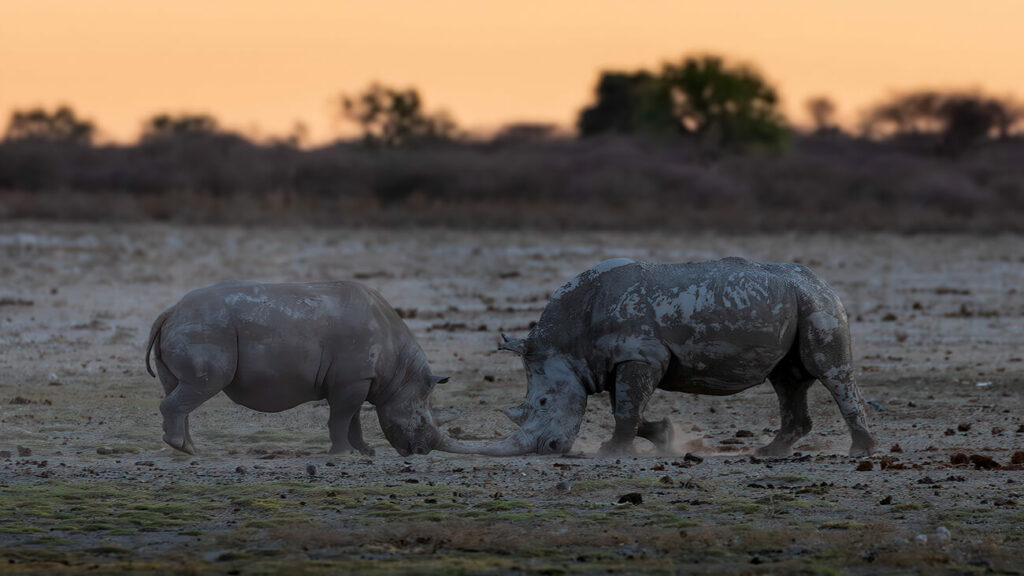Springboks in the Kalahari – Masters of Desert Survival
Discover the Springbok: The Kalahari’s Leaping Antelope
Springboks in the Kalahari, the iconic antelopes of southern Africa, thrive even in the seemingly harsh landscapes of the Kalahari Desert. Let’s explore their amazing adaptations, unique behaviors, and the conservation efforts needed to secure their future in this challenging environment.

Male Springbok at a waterhole in Khamab Kalahari Reserve
Quickfire Springbok Facts:
- Weight: Adult Springboks in the Kalahari can weigh between 27kg and 42 kg (60 lb and 93 lb)
- Speed: Springboks are fast and agile; they can reach speeds of up to 88 km/h (55 mph) , making them one of the fastest antelopes in the world. This speed allows them to evade predators and escape from danger.
- Diet: Springboks are herbivores, their diet consists mainly of grasses and shrubs. They browse primarily but are able to graze intermittently.
- Behavior and Social Structure: Springboks in the Kalahari are highly social animals, active mostly between dawn and dusk, they live in large herds that can consist of hundreds of individuals. Springbok rest during the heat of the day, and in the hotter months are known to feed at night. They communicate with each other through a variety of vocalizations, such as snorts and barks. They have a complex social hierarchy, with dominant males at the top of the herd. Bachelor herds occur, and males often wonder from herds in search of mates.
- Reproduction: Springboks have a gestation period of approximately 5 months. Litters typically consist of one calf and most commonly during spring.
- Threats: Habitat loss due to human development and agriculture is a major threat to Springboks. Historically, millions of springboks used to gather together to migrate, known as trekbokking, which would stretch hundreds of kilometres long and take several days to pass through towns. Due to habitat loss, this is no longer possible, at least no to the same scale. They are also hunted for their meat and hides. Disease can equally be a problem for Springbok populations.
- Conservation Status: Springboks are considered to be a Least Concern species by the IUCN, with a wide range and relatively stable population.
Taxonomy and Origins: South Africa’s National Animal
Springboks (Antidorcas marsupialis) belong to the Bovidae family, which includes cattle, sheep, and other antelopes. They are the sole species within the genus Antidorcas and proudly hold the title of South Africa’s national animal. Fossil evidence suggests Springboks have roamed southern Africa for a significant portion of antelope evolutionary history.
Size and Appearance: Built for Speed and Agility
Springboks are medium-sized antelopes, weighing 27-42 kg (60-93 lbs) and standing approximately 75 cm (30 inches) tall at the shoulder. Their most striking feature is their white and brown coat with a dark stripe along the flank. Both males and females sport elegant, lyre-shaped horns.

Adaptations for Springboks in the Kalahari: Beating the Heat
Springboks possess several remarkable adaptations that enable them to thrive in the Kalahari. They can go long periods without drinking, obtaining moisture from the plants they eat. A special network of blood vessels in their heads helps them cool down in the desert heat. In fact, Springboks can live their entire lives without needing to drink water.
Desert Sprinters: The Pronking Puzzle
Springboks in the Kalahari are renowned for their speed, reaching up to 88 km/h (55 mph) to escape predators. They also perform a unique leaping behavior called “pronking” where they jump stiff-legged into the air. The purpose of pronking is debated, but it may signal fitness to mates or serve as a warning to predators.
Social Lives: Strength in Numbers
Springboks are highly social, forming herds of up to thousands of individuals for protection and foraging. Within herds, there’s a complex hierarchy with dominant males defending territories. They communicate through snorts, barks, and even scent marking.
Temperament: Shy but Swift
Springboks in the Kalahari are generally shy and wary of humans, but their incredible agility allows them to escape danger with lightning speed. If cornered, they can defend themselves with their sharp horns.
Reproduction: Raising the Next Generation
Springboks breed throughout the year, though most calves are born in the spring and early summer. Gestation lasts around 5 months, and females give birth to a single calf. Calves hide in vegetation for the first few weeks, with their mothers returning to nurse them.
Distribution: Wide-Ranging, but Fragmented
Historically, vast herds of Springboks numbering in the millions roamed southern Africa, undertaking great migrations known as “trekbokking“. Today, populations are fragmented due to habitat loss. The Kalahari remains an important stronghold for the species.
Threats and Conservation: A Fight for the Future
Springboks in the Kalahari face challenges like habitat loss due to agriculture and development. Poaching for meat and hides poses an additional threat. Disease outbreaks can also impact populations. Conservation efforts focus on habitat protection, anti-poaching measures, and sustainable management practices.
FAQs: Your Springbok Questions Answered
The Kalahari’s Resilient Antelope
Springboks possess several remarkable adaptations that enable them to thrive in the Kalahari. They can go long periods without drinking, obtaining moisture from the plants they eat. A special network of blood vessels in their heads helps them cool down in the desert heat.
Want to see these animals for yourself? Join Our Project or Contact Us for any other questions!
Read more about Springboks here






